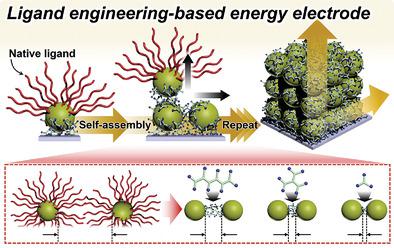当前位置:
X-MOL 学术
›
Adv. Mater.
›
论文详情
Our official English website, www.x-mol.net, welcomes your
feedback! (Note: you will need to create a separate account there.)
Nanoparticle-Based Electrodes with High Charge Transfer Efficiency through Ligand Exchange Layer-by-Layer Assembly.
Advanced Materials ( IF 27.4 ) Pub Date : 2020-09-21 , DOI: 10.1002/adma.202001924 Yongmin Ko 1, 2 , Cheong Hoon Kwon 1 , Seung Woo Lee 3 , Jinhan Cho 1
Advanced Materials ( IF 27.4 ) Pub Date : 2020-09-21 , DOI: 10.1002/adma.202001924 Yongmin Ko 1, 2 , Cheong Hoon Kwon 1 , Seung Woo Lee 3 , Jinhan Cho 1
Affiliation

|
Organic‐ligand‐based solution processes of metal and transition metal oxide (TMO) nanoparticles (NPs) have been widely studied for the preparation of electrode materials with desired electrical and electrochemical properties for various energy devices. However, the ligands adsorbed on NPs have a significant effect on the intrinsic properties of materials, thus influencing the performance of bulk electrodes assembled by NPs for energy devices. To resolve these critical drawbacks, numerous approaches have focused on developing unique surface chemistry that can exchange bulky ligands with small ligands or remove bulky ligands from NPs after NP deposition. In particular, recent studies have reported that the ligand‐exchange‐induced layer‐by‐layer (LE‐LbL) assembly of NPs enables controlled assembly of NPs with the desired interparticle distance, and interfaces, dramatically improving the electrical/electrochemical performance of electrodes. This emerging approach also demonstrates that efficient surface ligand engineering can exploit the unique electrochemical properties of individual NPs and maximize the electrochemical performance of the resultant NP‐assembled electrodes through improved charge transfer efficiency. This report focuses on how LE‐LbL assembly can be effectively applied to NP‐based energy storage/conversion electrodes. First, the basic principles of the LE‐LbL approach are introduced and then recent progress on NP‐based energy electrodes prepared via the LE‐LbL approach is reviewed.
中文翻译:

通过配体交换的逐层组装,具有高电荷转移效率的基于纳米粒子的电极。
对金属和过渡金属氧化物(TMO)纳米颗粒(NPs)的有机配体溶液处理工艺进行了广泛研究,以制备具有各种电气设备所需的电气和电化学性能的电极材料。但是,吸附在NPs上的配体对材料的固有性质有重大影响,因此会影响NPs组装的能量电极体电极的性能。为了解决这些关键缺陷,许多方法集中于开发独特的表面化学,该表面化学可以将大的配体与小配体交换或在NP沉积后从NP中去除大的配体。特别是,最近的研究表明,NP的配体交换诱导的逐层(LE-LbL)组装能够以所需的粒子间距离控制NP的组装,和界面,大大改善了电极的电/电化学性能。这种新兴方法还表明,有效的表面配体工程可以利用单个NP的独特电化学特性,并通过提高电荷转移效率来最大程度地提高所得NP组装电极的电化学性能。本报告重点介绍如何将LE‐LbL组件有效地应用于基于NP的储能/转换电极。首先,介绍了LE‐LbL方法的基本原理,然后回顾了通过LE‐LbL方法制备的基于NP的能量电极的最新进展。这种新兴方法还表明,有效的表面配体工程可以利用单个NP的独特电化学特性,并通过提高电荷转移效率来最大程度地提高所得NP组装电极的电化学性能。本报告重点介绍如何将LE‐LbL组件有效地应用于基于NP的储能/转换电极。首先,介绍了LE‐LbL方法的基本原理,然后回顾了通过LE‐LbL方法制备的基于NP的能量电极的最新进展。这种新兴方法还表明,有效的表面配体工程可以利用单个NP的独特电化学特性,并通过提高电荷转移效率来最大程度地提高所得NP组装电极的电化学性能。本报告重点介绍如何将LE‐LbL组件有效地应用于基于NP的储能/转换电极。首先,介绍了LE‐LbL方法的基本原理,然后回顾了通过LE‐LbL方法制备的基于NP的能量电极的最新进展。本报告重点介绍如何将LE‐LbL组件有效地应用于基于NP的储能/转换电极。首先,介绍了LE‐LbL方法的基本原理,然后回顾了通过LE‐LbL方法制备的基于NP的能量电极的最新进展。本报告重点介绍如何将LE‐LbL组件有效地应用于基于NP的储能/转换电极。首先,介绍了LE‐LbL方法的基本原理,然后回顾了通过LE‐LbL方法制备的基于NP的能量电极的最新进展。
更新日期:2020-09-21
中文翻译:

通过配体交换的逐层组装,具有高电荷转移效率的基于纳米粒子的电极。
对金属和过渡金属氧化物(TMO)纳米颗粒(NPs)的有机配体溶液处理工艺进行了广泛研究,以制备具有各种电气设备所需的电气和电化学性能的电极材料。但是,吸附在NPs上的配体对材料的固有性质有重大影响,因此会影响NPs组装的能量电极体电极的性能。为了解决这些关键缺陷,许多方法集中于开发独特的表面化学,该表面化学可以将大的配体与小配体交换或在NP沉积后从NP中去除大的配体。特别是,最近的研究表明,NP的配体交换诱导的逐层(LE-LbL)组装能够以所需的粒子间距离控制NP的组装,和界面,大大改善了电极的电/电化学性能。这种新兴方法还表明,有效的表面配体工程可以利用单个NP的独特电化学特性,并通过提高电荷转移效率来最大程度地提高所得NP组装电极的电化学性能。本报告重点介绍如何将LE‐LbL组件有效地应用于基于NP的储能/转换电极。首先,介绍了LE‐LbL方法的基本原理,然后回顾了通过LE‐LbL方法制备的基于NP的能量电极的最新进展。这种新兴方法还表明,有效的表面配体工程可以利用单个NP的独特电化学特性,并通过提高电荷转移效率来最大程度地提高所得NP组装电极的电化学性能。本报告重点介绍如何将LE‐LbL组件有效地应用于基于NP的储能/转换电极。首先,介绍了LE‐LbL方法的基本原理,然后回顾了通过LE‐LbL方法制备的基于NP的能量电极的最新进展。这种新兴方法还表明,有效的表面配体工程可以利用单个NP的独特电化学特性,并通过提高电荷转移效率来最大程度地提高所得NP组装电极的电化学性能。本报告重点介绍如何将LE‐LbL组件有效地应用于基于NP的储能/转换电极。首先,介绍了LE‐LbL方法的基本原理,然后回顾了通过LE‐LbL方法制备的基于NP的能量电极的最新进展。本报告重点介绍如何将LE‐LbL组件有效地应用于基于NP的储能/转换电极。首先,介绍了LE‐LbL方法的基本原理,然后回顾了通过LE‐LbL方法制备的基于NP的能量电极的最新进展。本报告重点介绍如何将LE‐LbL组件有效地应用于基于NP的储能/转换电极。首先,介绍了LE‐LbL方法的基本原理,然后回顾了通过LE‐LbL方法制备的基于NP的能量电极的最新进展。











































 京公网安备 11010802027423号
京公网安备 11010802027423号